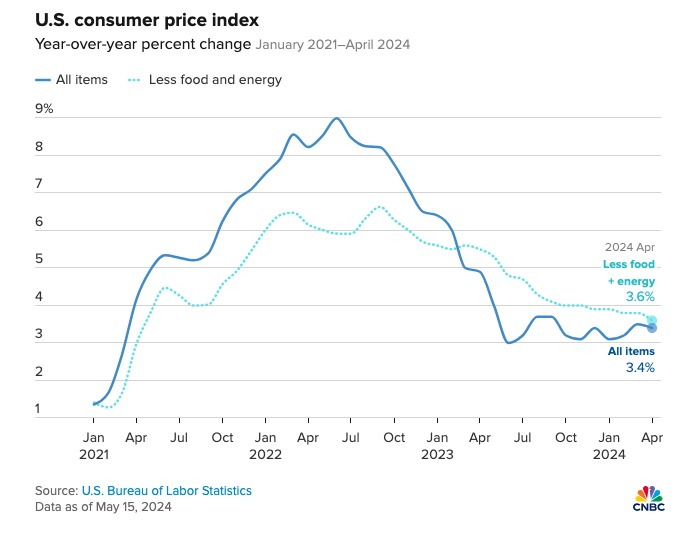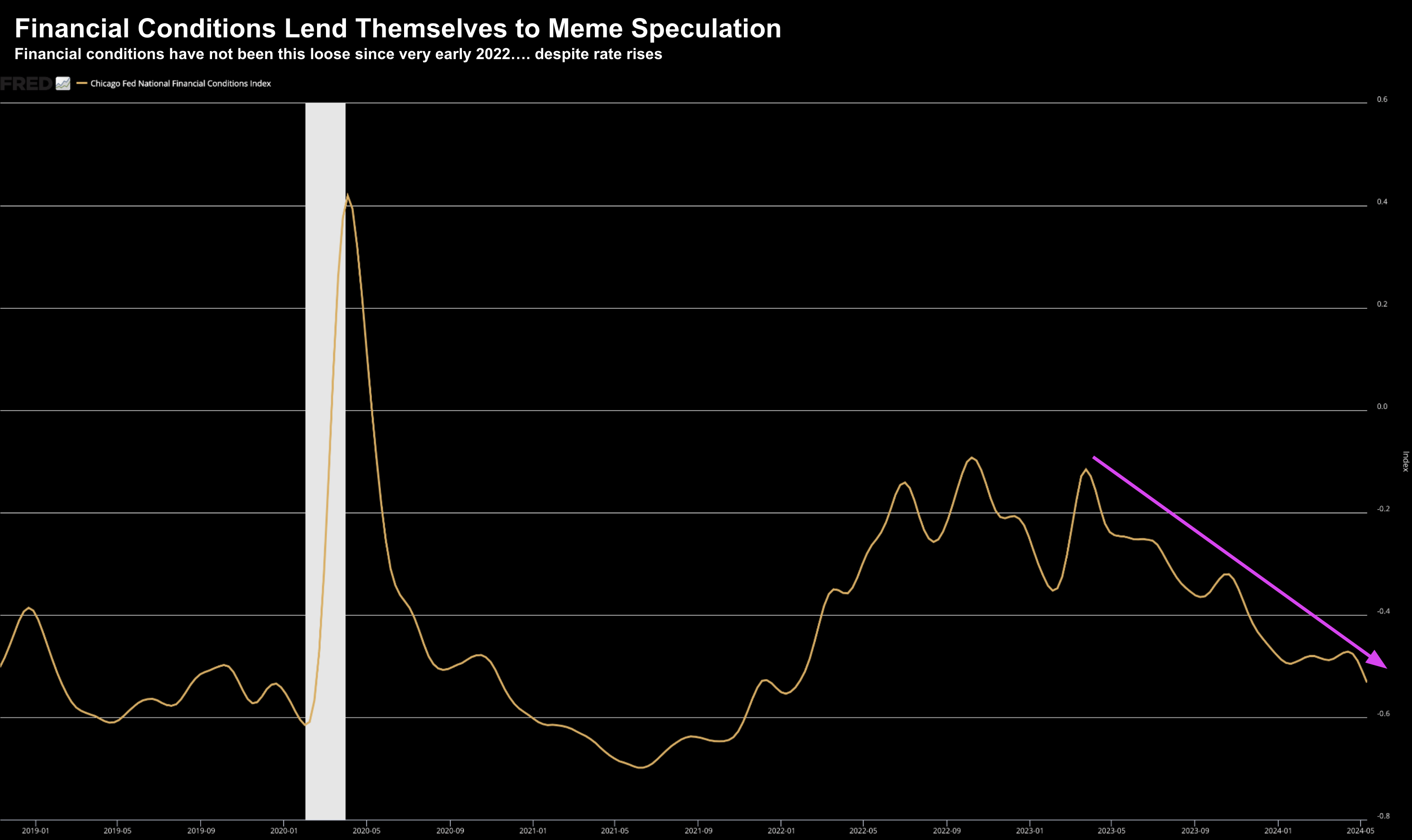- Markets only see good news
- Retail sales plunge… not a surprise
- Don’t fight the tape
After almost three decades at this game – something you learn is not to fight the tape.
Trade against momentum at your own peril.
Consider the news today…
We had both bad and good news.
I will start with the (perceived) ‘good news’.
The Consumer Price Index (CPI) was slightly cooler than expected.
And whilst it’s still a long way above the Fed’s target of 2.0% – the market was thrilled it was “only” up 0.3% MoM and 3.4% YoY
Bond yields plunged and stocks ripped.
Sure…
3.4% isn’t great (far from it)… but that’s Main Street’s problem.
Wall Street doesn’t care.
The MoM result was better than the 0.4% the market expected… and from its lens… that’s a positive.
As this CNBC chart shows, CPI was at ~1.5% in early 2021.
However, with the government spending spigots on full-tilt (long after the pandemic was firmly behind us) – excess money chasing too few goods saw it soar to 9% (more on this in my conclusion).
And whilst we’re no longer at nose-bleed inflation levels – getting it from 4.0% to 2.0% was always going to be a harder fight.
The problem?
Inflation remains sticky… especially in harder to shift areas like shelter.
And the bad news?
Retail sales were miserable.
The headline number came in flat, well below the 0.4% rise that was expected.
That said, why the surprise?
Consumers are mostly tapped out – with many people relying on credit to make basic ends meet.
From NPR this week:
More Americans are falling behind on their credit card bills.
About 8.9% of credit card balances fell into delinquency over the last year, according to the Federal Reserve Bank of New York — a sign that a growing number of borrowers are feeling the strain of rising prices and high interest rates.
“Everything is more expensive. Debt is more expensive. Rent is more expensive. Food, gas, everything,” says Charlie Wise, senior vice president at TransUnion, the credit reporting firm.
“Even with relatively healthy wage gains we’ve seen over the last several years, many consumers just aren’t keeping up with the price pressures.”
Kitchen table issues.
This is what will most likely decide the election.
And whilst the political leaders will say “inflation is coming down” – it’s misleading.
Prices are still going up 3.4% YoY… however they’re not going up as fast.
That’s what changed.
Put it this way – we are still at least 20% higher than what we saw in 2020.
This week we get earnings from Walmart…
They will give us a good read of how middle-to-lower income households are fairing with higher prices.
Or are Walmart attracting higher income families due to the price increases. Don’t be surprised to hear this narrative.
Speaking of which….
Retail Sales Stink
I was not surprised to see softness in retail.
For example, over the past few weeks, we’ve heard ample warnings from luxury goods companies of slowing demand.
Now, if the wealthy are pulling back their spending – what’s that say about lower cohorts?
Typically the last domino to pull in their horns are generally the ‘well-to-do’.
Consider these two data points from retailers:
- Luxury apparel company Burberry Group’s results for the fiscal year ended March 30 missed the company’s guidance with slowing demand for high-end products creating challenges. For the 12-month period, earnings declined but exceeded analysts’ forecasts. Revenue also fell but was roughly in-line with estimates. In the most recent quarter, comparable same store sales fell 12% y/y. Overall sales declined in all the company’s regions—Asia Pacific, EMEIA and the Americas. The company anticipates that the first half of its current fiscal year will be difficult, but it believes the second half will be strong as Burberry’s efforts to strengthen its brand and reduce costs to offset the impact of inflation kick in.
- Boot Barn, a provider of Western-styled apparel, also posted disappointing results. Its recent-quarter earnings per share and revenue declined 34% and 8.7% y/y, respectively. However, both metrics exceeded analyst consensus expectations. Even though the quarter was one week shorter than in 2023, Boot Barn’s expenses climbed, a result of higher marketing costs, incentive-based compensation and increased wages for store employees
According to CNBC, the advance estimate for retail sales in April showed no change on the month after increasing a downwardly revised 0.6% in March.
A 1.2% decline in online receipts held the sales figure back, as did a 0.9% slide in sporting goods and related stores, while motor vehicles and parts dealers posted a 0.8% decrease.
The so-called control group, which excludes a number of items and feeds into the Commerce Department’s gross domestic product calculations, fell by 0.3%.
“The weaker than expected retail sales number needs to be watched – cooling consumer spending is good, but if that transitions into a deeper slowdown it could herald some economic problems that markets would not welcome,” said Seema Shah, chief global strategist at Principal Asset Management.
But here’s the thing:
A slowdown in retail sales is just more “good news” from the market’s perspective.
Not only is “good news” good news – so too is “bad news”.
Why?
Because it gives the Fed more ammunition to cut rates.
For shits and giggles – let’s pretend the retail sales number came in hotter than expected.
What do you think the narrative would have been?
“This is very good news – we have strong spending consumer – expect a soft-landing – buy stocks”
This is a case of heads I win and tails you lose.
Don’t Fight the Tape
As I was writing over the weekend, this is a momentum driven market.
Don’t get in its way.
This is what happens when it’s ‘heads I win and tails you lose’ environment.
The path of least resistance will be higher.
If you need evidence, look no further than what we see with the resurgence of so-called “meme” stocks.

2021 meme favourites such as “Gamestop” and “AMC” have ripped higher in recent sessions as “Roaring Kitty” resurfaces on X from his 3-year hiatus (n.b., Robinhood investors will be salavating).
Now if you want evidence the market is frothy (or there’s rampant speculation) – this headline says it all.
As regular readers know, I don’t bother wasting pixels on ultra-low quality stocks – it’s not my beat.
I would rather count cards playing Blackjack (tilting the odds in my favour)
However, what I do know is rubbish doesn’t soar in risk-off markets.
And these stocks are rubbish (along with stocks like DJT)
Speculate at your own risk.
And only outlay what you can afford to lose.
Putting it All Together
One last chart before I sign off…
Take a look the 2-year trend in financial conditions (as it tells us a lot about the risk-on environment)
The last time meme stocks took off was 2021 when the federal funds rate was 0% and the Fed was adding $120B per month in liquidity.
What’s more, Biden had the fiscal pumps primed handing out stimulus checks, unemployment benefits and so-called “PPP loans”.
In short, the system was awash with liquidity.
Fast forward to 2024.
The Fed jacked up rates to 5.5% and more recently QT.
However, the government continues to prime the pump.
Now you might think the Fed’s tightening measures were enough to slow things down?
Not quite.
In short, the sheer amount of stimulus over the past few years was so large (monetary and fiscal) – the Fed’s measures were not enough to curb asset speculation.
Once again I’m reminded of former Fed Chair Paul Volcker’s warning:
“The real danger with monetary policy comes from encouraging or inadvertently tolerating rising inflation and its close cousin of extreme speculation and risk taking, in effect standing by while bubbles and excesses threaten financial markets”
Whilst not a risk in the near-term – over the next two to three years we will likely see how prudent Volcker’s warning is.
For now, it’s risk on.


